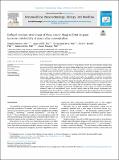Por favor, use este identificador para citar o enlazar a este item:
http://hdl.handle.net/10261/340627COMPARTIR / EXPORTAR:
 SHARE SHARE
 CORE
BASE CORE
BASE
|
|
| Visualizar otros formatos: MARC | Dublin Core | RDF | ORE | MODS | METS | DIDL | DATACITE | |

| Título: | Defined covalent attachment of three cancer drugs to DNA origami increases cytotoxicity at nanomolar concentration |
Autor: | Navarro, Natalia CSIC ORCID ; Aviñó, Anna CSIC ORCID; Domènech, Òscar; Borrell, Jordi H; Eritja Casadellà, Ramón CSIC ORCID ; Fàbrega, Carme CSIC ORCID | Palabras clave: | Cancer nanomedicine Combination therapy Covalent conjugation DNA nanotechnology DNA origami Drug conjugates |
Fecha de publicación: | ene-2024 | Editor: | Elsevier | Citación: | Nanomedicine: Nanotechnology, Biology and Medicine 55: 102722 (2024) | Resumen: | DNA nanostructures have captured great interest as drug delivery vehicles for cancer therapy. Despite rapid progress in the field, some hurdles, such as low cellular uptake, low tissue specificity or ambiguous drug loading, remain unsolved. Herein, well-known antitumor drugs (doxorubicin, auristatin, and floxuridine) were site-specifically incorporated into DNA nanostructures, demonstrating the potential advantages of covalently linking drug molecules via structural staples instead of incorporating the drugs by noncovalent binding interactions. The covalent strategy avoids critical issues such as an unknown number of drug-DNA binding events and premature drug release. Moreover, covalently modified origami offers the possibility of precisely incorporating several synergetic antitumor drugs into the DNA nanostructure at a predefined molar ratio and to control the exact spatial orientation of drugs into DNA origami. Additionally, DNA-based nanoscaffolds have been reported to have a low intracellular uptake. Thus, two cellular uptake enhancing mechanisms were studied: the introduction of folate units covalently linked to DNA origami and the transfection of DNA origami with Lipofectamine. Importantly, both methods increased the internalization of DNA origami into HTB38 and HCC2998 colorectal cancer cells and produced greater cytotoxic activity when the DNA origami incorporated antiproliferative drugs. The results here present a successful and conceptually distinct approach for the development of DNA-based nanostructures as drug delivery vehicles, which can be considered an important step towards the development of highly precise nanomedicines. | Versión del editor: | https://doi.org/10.1016/j.nano.2023.102722 | URI: | http://hdl.handle.net/10261/340627 | DOI: | 10.1016/j.nano.2023.102722 | ISSN: | 15499634 |
| Aparece en las colecciones: | (IQAC) Artículos |
Ficheros en este ítem:
| Fichero | Descripción | Tamaño | Formato | |
|---|---|---|---|---|
| 1-s2.0-S1549963423000734-main.pdf | Artículo principal | 4,56 MB | Adobe PDF |  Visualizar/Abrir |
| 1-s2.0-S1549963423000734-mmc1.docx | Material suplementario | 5,08 MB | Microsoft Word XML | Visualizar/Abrir |
CORE Recommender
SCOPUSTM
Citations
1
checked on 21-may-2024
Page view(s)
17
checked on 21-may-2024
Download(s)
9
checked on 21-may-2024
Google ScholarTM
Check
Altmetric
Altmetric
NOTA: Los ítems de Digital.CSIC están protegidos por copyright, con todos los derechos reservados, a menos que se indique lo contrario.


